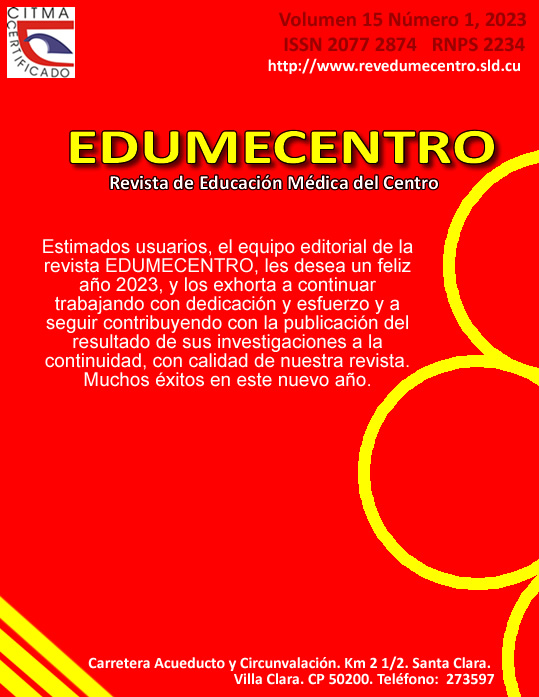Model to train young people from the Manicaragua municipality, Cuba, on risk perception in HIV/AIDS
Keywords:
community medicine, behavioral medicine, training coursesAbstract
Background: HIV/AIDS is a health problem characterized by a severe compromise of immunity; this entity constitutes a risk factor for the development of the main causes of death worldwide.Objective: to propose a model to train young people from the Doctor´s office 41 in the Manicaragua health area on risk perception on HIV/AIDS.
Methods: an observational, descriptive, cross-sectional study was carried out in the Doctor´s office 41 of the Manicaragua health area in the province of Villa Clara. Theoretical methods were applied: historical-logical, analysis synthesis, induction-deduction, systemic-structural and modeling; empirical ones: the questionnaire for young people and the conflict story; mathematical-statisticians for data analysis.
Results: the most frequent deficiencies in risk perception were related to deficiencies in information, understanding and decision-making for health prevention. A model for training in risk perception to face HIV/AIDS is offered, which was assessed by specialist criteria.
Conclusions: the model enables the acquisition of behaviors that promote sexual health, understanding and predicting how to respond to the dangers of the disease, contributing to the change of intention and behavior, and assuming protective attitudes. It was valued as accepted by the specialists consulted.
Downloads
References
1. Pérez Rosabal E, Soler Sánchez YM, Pérez Rosabal R, López Arias E, Leyva Rodríguez VV. Conocimientos sobre VIH/sida, percepción de riesgo y comportamiento sexual en estudiantes universitarios. Multimed [Internet]. 2018 [citado 23/10/2022];20(1):[aprox. 10 p.]. Disponible en: http://www.revmultimed.sld.cu/index.php/mtm/article/view/128/176
2. Bien M, Sol Y, Yero Y, Ricardo L, Carmona A. Estrategia de prevención para disminuir el índice de contagio por VIH/SIDA. Policlínico Bayamo. 2018. Multimed [Internet]. 2020 [citado 21/10/2022];24(3):[aprox. 14 p.]. Disponible en: http://scielo.sld.cu/scielo.php?script=sci_arttext&pid=S1028-48182020000300557&lng=es&tlng=es
3. Herrera Gallardo F, Jorquera Gutiérrez R. Propiedades Psicométricas de la Escala de Percepción de Riesgo de VIH en una Muestra de Adolescentes Chilenos, 2018. Rev Haban Cienc Med [Internet]. 2020 [citado 23/10/2022];19(3):e2923. Disponible en: http://www.revhabanera.sld.cu/index.php/rhab/article/view/2923/2595
4. León VE, Rincón EE, Duque L. Revisión y análisis de las pandemias más devastadoras de la humanidad: de la antigüedad hasta la actualidad. Rev Nure Investigac [Internet]. 2020 [citado 02/10/2022];(108):[aprox. 16 p.]. Disponible en: https://www.nureinvestigacion.es/OJS/index.php/nure/article/view/1991
5. Rodríguez A, Martínez B, Prieto R, Rodríguez M, Torrado G. Conocimientos sobre VIH en personas de 15 a 24 años. Rev Cuba Med Gen Integr [Internet]. 2019 [citado 23/10/2022];35(1):[aprox. 15 p.]. Disponible en: http://www.revmgi.sld.cu/index.php/mgi/article/view/734
6. Barbosa RL, González R. Propuesta de intervención educativa sobre VIH/sida para adolescentes de un consultorio médico. Universidad Médica Pinareña [Internet]. 2020 [citado 23/10/2022];16(3):[aprox. 11 p.]. Disponible en: https://www.medigraphic.com/cgi-bin/new/resumen.cgi?IDARTICULO=95542&id2
7. López D, Rodríguez AM, Peña M. Conductas sexuales de riesgo para infecciones de transmisión sexual en adolescentes. Novedades en Población [Internet]. 2020 [citado 23/10/2022];16(31):[aprox. 14 p.]. Disponible en: http://scielo.sld.cu/pdf/rnp/v16n31/1817-4078-rnp-16-31-187.pdf
8. Aguilar G, Kawabata A, Samudio T, Rios-Gonzalez CM. Comportamiento epidemiológico del VIH en Paraguay, 2017. Rev de Salud Pública del Paraguay [Internet]. 2018 [citado 23/10/2022];8(2):[aprox. 6 p.]. Disponible en: https://doi.org/10.18004/rspp.2018.diciembre.9-14
9. Balarezo G. El impacto social del SIDA en el siglo XX. [Internet]. Lima, Perú: Universidad Nacional Mayor de San Marcos; 2022. Disponible en: https://repositorioacademico.upc.edu.pe/bitstream/handle/10757/601012/El+Impacto+Social+SIDA+en+el+Siglo+XX.pdf?sequence=1
10. Alfonso Figueroa L, Santillano Cárdenas I, Figueroa Perez L, Rodríguez Gonzalez A, Garcia Breto L. Prevención de las conductas sexuales de riesgo en adolescentes del municipio Consolación del Sur. Rev de Ciencias Médicas de Pinar del Río [Internet]. 2020 [citado 23/10/2022];24(4):[aprox. 18 p.]. Disponible en: http://revcmpinar.sld.cu/index.php/publicaciones/article/view/4318
11. Soto Silva A. La infección por VIH en tiempos de pandemia: muchos retrocesos, innumerables desafíos. Rev Chilena de Infectología [Internet]. 2022 [citado 23/10/2022];39(3):[aprox. 6 p.]. Disponible en: https://dx.doi.org/10.4067/s0716-10182022000200287
12. Arminda Tandala BM, Suárez Estévez Á. La educación de la percepción de riesgo en la prevención de ITS/VIH-SIDA. Varona [Internet]. 2019 [citado 23/10/2022];(69):[aprox. 13 p.]. Disponible en: http://scielo.sld.cu/scielo.php?script=sci_arttext&pid=S1992-82382019000200003&lng=es&tlng=es
13. Llanes Ll, Peñate A, Medina JM. Percepción de riesgo sobre VIH/SIDA en jóvenes becarios de primer año de Medicina. Medicent Electron [Internet]. 2020 [citado 23/10/2022];24(1):[aprox. 8 p.]. Disponible en: http://scielo.sld.cu/scielo.php?script=sci_arttext&pid=S1029-30432020000100185&lng=es&tlng=es
Published
How to Cite
Issue
Section
License
Los autores que publican en esta revista están de acuerdo con los siguientes términos:- Los autores/as conservarán sus derechos de autor y ceden a la revista el derecho de primera publicación de su obra, el cuál estará simultáneamente sujeto a una Licencia Creative Commons Reconocimiento-NoComercial-CompartirIgual 4.0 Internacional (CC BY-NC-SA 4.0) que permite a terceros compartir la obra siempre que se indique su autor y su primera publicación esta revista.
- Los autores pueden establecer por separado acuerdos adicionales para la distribución no exclusiva de la versión de la obra publicada en la revista (por ejemplo, situarlo en un repositorio institucional o publicarlo en un libro), con un reconocimiento de su publicación inicial en esta revista.
- Se permite y se anima a los autores a difundir sus trabajos electrónicamente (por ejemplo, en repositorios institucionales o en su propio sitio web) antes y durante el proceso de envío, ya que puede dar lugar a intercambios productivos, así como a una citación más temprana y mayor de los trabajos publicados (Véase The Effect of Open Access) (en inglés).










